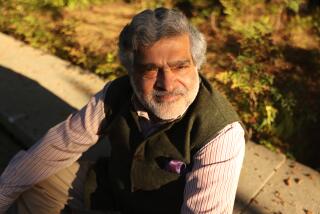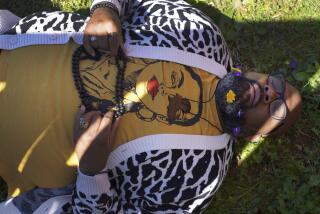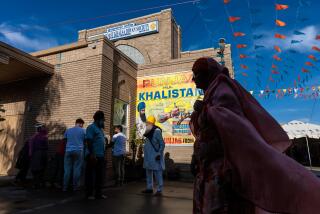A yogi’s requiem
- Share via
Before he was Yogi Bhajan -- kundalini master, Sikh missionary, lifestyle sage and political advisor with 300 yoga centers and 4,000 instructors, more than a dozen corporations and $1 billion in government contracts for security -- he was Harbhajan Singh Khalsa Puri, an ex-civil servant who landed in Los Angeles at the dawn of the city’s guru boom and inspired the hippie masses with his movie star charisma and exotic health regimen.
Bhajan, 75, died Oct. 6 of heart failure at his home in Espanola, N.M., and today hundreds of his devotees and state dignitaries will gather there at his Hacienda de Guru Ram Das ashram to pray, chant and sing in his memory. The event will be broadcast live over the Internet to yoga centers and ashrams all over the world.
Bhajan’s is a fantastic story, and according to his followers his success came from a diverse mix of reincarnation, Hinduism, telepathy, mysticism, political savvy and a larger-than-life persona. It’s a tale passed on by the original cadre of L.A. hippies -- actors, musicians and seekers -- who forsook their American ways in the late 1960s and early ‘70s to become the first western Sikhs and kundalini colonists.
On the eve of his memorial, they recalled the early days when Bhajan was a good-looking Indian mystic in his 30s, who wore a turban, a long black beard and black velvet shoes turned up at the toes. “He was very spectacular,” says Shakti Parwha Kaur Khalsa, one of his original students. Like other hippie gurus of the late 1960s, Bhajan claimed to possess the ancient wisdom to soothe their drug-addled minds. He told them he’d come to “the City of Angels” because it was the natural home of the Aquarian Age and a place of ideas that inspired the world. “I didn’t come to gain students,” he famously said. “I came to train teachers.”
But students flocked to him. Women so adored him, it became an honor just to wash his feet. Men longed for his approval. They trusted him to arrange their marriages and select their careers. Within a few weeks of arriving here, Bhajan had a green-card sponsor in singer Johnny Rivers, who then introduced him to an antiques store owner. That West Hollywood shop became the site of Bhajan’s first classes. Soon, he was a regular at local love-ins, telling the hippies there, “I can get you high -- high on your breath.”
He brought to America his version of the Hindu practice of kundalini, a rigorous yoga involving meditation, chanting and repetitive movement coupled with breathing exercises believed to harmonize the body’s energy centers.
“He won us all over,” says famed kundalini instructor and Hollywood pregnancy guru Gurmukh Kaur Khalsa, who met Bhajan in 1970, when she was 28. “He gave us a lifestyle. He gave us a way to live in marriage, in relationships, how to raise children, what to eat, how to even use the power of cold water, how to heal yourself.”
Over the years, Bhajan achieved remarkable recognition from governors, legislators, heads of state, and other religious leaders -- the pope and Dalai Lama among them. After Bhajan’s death, Rep. Mark Udall (D-Colo.) proposed a congressional resolution in his honor. New Mexico’s Gov. Bill Richardson ordered flags flown at half-staff. And India’s prime minister sent flowers to his cremation ceremony. His bearded image appears in nearly every kundalini studio in the world and on every box of his Yogi Tea, the product of the second largest herbal tea company in the U.S.
And yet, Bhajan’s legacy wasn’t immune to controversy. While many see him as a tireless missionary whose only goal was to serve humanity, others considered him a brilliant cult leader and masterful con man who lived the life of a rock star by exploiting his followers.
‘New yogi in town’
Shakti Parwha Kaur Khalsa had spent years traveling the world and studying Eastern religions when she met Bhajan at a Sanskrit lecture in Los Angeles in December 1968. She says he made an especially memorable impression by reading her mind during dinner. “He said ‘Your son’s in trouble isn’t he? ... Come and see me. I can help you.’ ”
A daily chant for 40 days before dawn would do the trick, he said. And sure enough, Shakti says, it worked. Soon she was cooking Bhajan’s lunch, shuttling him around town, finding people to host his lectures, even coordinating donors to pay the $50 per month for his room. Shakti says her work was a sign of her faith in Bhajan’s mission. “It was so real for him,” she says. “And it was contagious.”
A month later, Guru Singh Khalsa, a singer-songwriter with a record contract, heard from a friend that Bhajan was the “new yogi in town ... and whatever he has, he’s got it in large quantities.” By then, Bhajan was holding evening classes at the antiques store at Melrose Avenue and Robertson Boulevard because he’d been kicked out of the East-West Cultural Center for attracting such large gatherings of hippies.
Gurmukh Kaur Khalsa was Mary Mae Gibson back then, divorced and childless after the death of her infant son. She was traveling around the country, dropping acid, taking diet pills and living in a tent, bartering for food with walnuts she found in the woods. A friend brought her to one of Bhajan’s yoga workshops in Tucson and before long, Bhajan had put her to work, cleaning his house and caring for his sick father.
Bhajan’s devotees worked hard for their guru’s approval. He demanded they rise before dawn for cold showers and hours of chanting, and routinely fast. He could be a screamer, they said, who ignored some and lavished others with gifts and praise. They note he was a Virgo with a perfectionist streak. Bhajan once lectured for 90 minutes on the subconscious reasons someone left a kitchen cabinet door ajar. Still, his followers considered their hard work a blessing because they trusted that Bhajan could help them elevate their souls.
He told Gurmukh she was “to deliver babies” and now she’s Hollywood’s premier pregnancy guru. He told Krishna Kaur, an African American actress in the 1960s, to bring her wisdom to the black community. She founded the Assn. of Black Yoga Teachers and established an ashram in South Los Angeles.
“You just longed for him to even yell at you, or tell you to do something, because so much love was coming out of it,” Gurmukh says.
Most of Bhajan’s devotees interviewed for this story believe he predicted their futures while acknowledging that these claims sound fantastic. “A lot of things he did are hard to understand out of context,” says Kirtan Singh Khalsa, a longtime devotee who manages the L.A. ashram on South Robertson Boulevard.
As Bhajan told it, he began his yogic training at age 8 and was declared a master of kundalini at 16 1/2 . At 18, he led a village of 7,000 people 325 miles on foot to safety during the turmoil of 1947 that led to a portion of India becoming Pakistan. Then his life took a decidedly pedestrian turn. He earned an economics degree and spent many years as a civil servant with India’s internal revenue service and customs agency.
The turning point came around 1964. Bhajan was sitting outside a Sikh gurdwara, listening to music, when he claimed to use his yogic powers to stop the rain. An Indian saint reprimanded him for his pomposity and ordered him to humble himself. So Bhajan got transferred to Amritsar, India -- home to the holiest site in the Sikh faith, the Golden Temple -- so he could wash the floors every day as penance.
Four years later, he received a vision that America’s hippies needed his guidance. Eventually, Bhajan was dispatching his newly indoctrinated teachers to Tucson, Houston, Phoenix, New York and elsewhere, instructing them to rent big houses, call them ashrams, serve food, rise before dawn, work hard and spread his teachings.Over the years, Bhajan became a generous political donor to both parties and established strong ties to the New Mexico governorship. Richardson considered him a trusted advisor and loyal ally.
“Besides his wonderful spiritual side,” Richardson says, “there was a very pragmatic political operator who was always protective of his Sikh community.”
Intentions questioned
To Bhajan’s followers he was a tireless giver, prescient sage and bon vivant who loved a good joke, fine jewels, song and dance. They quote him constantly and consider his teachings sacred. But critics note there were serious charges leveled at Bhajan in the 1980s, accusations his followers dismiss as fabrications, but that raise doubt concerning the yogi’s intentions.
“People basically deferred their critical thinking to Yogi Bhajan and leaders of the group,” says cult expert Rick Ross, who has counseled former Bhajan devotees and has posted lawsuits filed against the yogi on his website. “The litany of complaints that have surrounded the group regarding abuse go back to the ‘70s: sexual, financial exploitation and allegations of child abuse. This is a group that has a deeply troubled history.”
Guru Jot Singh Khalsa, who managed Bhajan’s Virginia ashram, and Guru Jot’s son-in-law Albert Ellis, were convicted for importing tons of marijuana into the U.S. from Thailand during the 1980s. Guru Jot entered an Alford plea, which meant he admitted no guilt, but acknowledged the prosecution could likely prove its case.
Mark Baker, once the director of training for Bhajan’s Akal Security -- which guards airports, federal courts and military installations -- sued the yogi for intentionally misleading government officials to keep Baker from becoming a New Mexico state trooper when he suspected the drug trafficking. His case was settled out of court.
And Bhajan’s longtime personal assistant Pamela Dyson and another devotee, Katherine Felt, sued him in federal court, claiming Bhajan forced them to be his concubines and that they were beaten, starved, brainwashed and tricked out of thousands of dollars. Their cases were ultimately dropped. “We never paid a penny to them,” Kirtan Singh says.
Today, devotees consider those troubled days in the 1980s as the price Bhajan paid for fame. They vehemently deny claims that their worship is a cult. “At the beginning of Christianity, Jesus’ followers were considered a cult,” notes Kirtan Singh, acting as a spokesman for Bhajan’s group. And Bhajan, he says, was “nothing more than a spiritual individual who taught the Sikh religion and yoga meditation.”
Whatever his legacy, Bhajan’s impact is undeniable -- an immigrant-makes-good story with a yogic twist. He came to America with some big ideas, and ultimately his message reached tens of thousands. For his followers who celebrate his memory today, he was a life force. As Gurmukh tells it, “So many yogas, you go and you do it, but they don’t really tell you how to live.”
More to Read
Sign up for Essential California
The most important California stories and recommendations in your inbox every morning.
You may occasionally receive promotional content from the Los Angeles Times.










